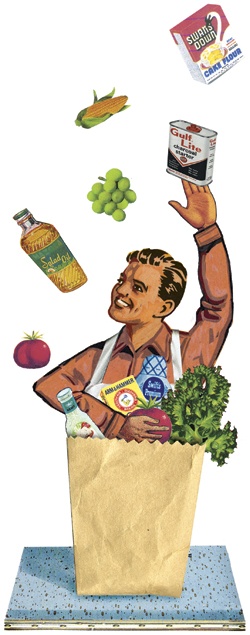My friend Stewart isn’t picky about how his groceries are bagged.
“They can chuck it in any way they want,” he says. “Just don’t squash the potato chips.”
Sorry, Stewart, but I’m jotting down a few more items on my grocery-bagging request list: Don’t pack my bags too heavy. Don’t pack ’em too light (surely there’s room for more than a tube of toothpaste and a box of baking soda in one plastic bag). Please ask me if I want paper or plastic (it’s paper; I still haven’t made the switch to cloth bags, which I know, I know, is the green thing to do). Please be gentle: Place, don’t throw, my bags of groceries into the shopping basket.
And above all, please be courteous: Eye contact and a smile still go a long way, especially when the checkout line is long, the conveyor belt is jammed and people’s nerves are frayed.
Yikes. I sound like a grouch. But I’m really not one of those shoppers. You know, the impatient ones who nearly run you over with their cart while you’re trying to pay or the angry ones who question the price of every item that’s been scanned. No, I remain poker-faced through it all, watching in silent horror as a misplaced half-gallon of Blue Bell ice cream smushes my whole-grain bread.
Clearly, I’m carrying emotional baggage into the grocery store. Maybe my memory’s faulty, but it seems that when I was a kid, there was always a capable bagger available to sack my mom’s groceries at the local Piggly Wiggly or United Supermarket. Everything went into paper sacks, and the baggers worked like magicians, deftly wielding cans of spinach and Ranch Style Beans, flipping them from one hand to the other and slipping them into the sack.
And back then, you always got carryout. It was a long, awkward walk through the parking lot, but the experience always ended pleasantly, with the bagger setting the groceries in the back of the station wagon, gingerly closing the door and saying, “Y’all have a good night.”
I miss full-service gas stations, too. But truthfully, when it comes to full-service treatment at the grocery store, I don’t want or need carryout. I just want my groceries to be coddled and pampered, as though every item were a fragile egg.
Clearly, I’m delusional and need to face the truth: Old-fashioned grocery bagging is a lost art. Or is it?
I did a little digging, and much to my delight, I found that good bagging is alive and well. First, there’s the National Grocers Association U.S.A. Best Bagger Championship held each February in Las Vegas. Contestants are judged on speed, bag-building technique, weight distribution among bags, style, attitude and appearance.
Texas wasn’t one of the 24 states represented at the 2009 U.S.A. championship, but by no means is the Lone Star State void of bagging talent.
Take, for example, H-E-B’s statewide bagging competition called S.T.A.R.S.S.—Striving To Always Role Model Superior Service—in which two-person teams, a bagger and a checker, race against the clock.
I hooked up with the 2008 second-place team, Karen Vasquez and Jesse Hopson, one Saturday afternoon at the H-E-B Plus in Round Rock, north of Austin.
As much as I complain about bagging, I sure can’t imagine myself doing it. So I asked Vasquez, 20, and Hopson, 17, for bagging lessons. With the blessings of their supervisor, Central Checkout Operations Manager Kim Gebert, I got a crash course in IPMs (items per minute), IPBs (items per bag), CAT (check all tops, meaning anything with a cap that might leak), building the walls (placing items such as cereal boxes along the sides so bags won’t collapse), building a produce pyramid (apples on bottom, bananas and cherries on the top) and the baggers’ creed: Greet, smile, think, offer carryout.
I learned basic bagging principles: “Colds to colds, red meat to red meat, veggies with veggies, Clorox by itself,” Vasquez recites. And chicken always goes in a plastic bag by itself.
I learned about mystery shoppers: H-E-B pays customers to come through the line and spy on checkers and baggers.
“If you’re a bagger, you have to offer carryout and you always have to have a positive attitude,” Gebert says. “You cannot exclude them (the customers) from your conversation.” Her command podium with its diagrams of all 29 checkout stations looks like something an air-traffic controller would use.
I tell Vasquez and Hopson that I’d panic as a new bagger. Nonsense, they say. First, you’d have a trainer beside you. And before I hit the floor, I’d take a baggers’ quiz, watch a training video, plow through a packet of paperwork and undergo Gebert’s rigorous interviewing process.
Hopson smiles reassuredly at me: “If you keep the fresh meat away from the chicken, build your walls, make your produce pyramid, and smile, you’ll be all right.”
I’m so shy sometimes, it might be hard to even ask, “Paper or plastic?” But there’s no time for shyness here: Baggers have to come out of their shells. After building a produce pyramid, Vasquez opens an egg carton and checks its contents. “Who wants to go home with cracked eggs?” she asks. “I wouldn’t.”
All the while, Vasquez is clearing the belt of groceries (there’s even a secret red button baggers push to keep items moving), holding the basket steady so a young boy can safely climb out, keeping the bacon away from the tomatillos and talking to people in line.
“You have to be efficient, not just fast,” she says, whirling around to address a customer. “Do you need help out to your car?”
Next, I accompany Hopson on a carryout. To generate conversation, he peers into customer Wanda Andrews’ basket. “You like hash browns? I like hash browns,” he says. “You can always find something to talk about.”
——————–
Camille Wheeler is staff writer for Texas Co-op Power.


